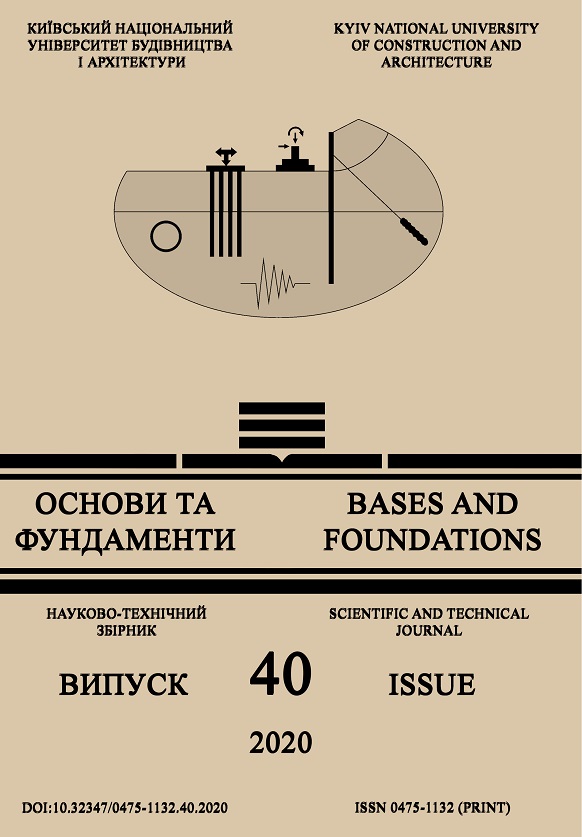Вплив жорсткості несучих конструкцій будинку зі збірного залізобетону на напружено-деформований стан фундаментів із буроін’єкційних паль
Основний зміст сторінки статті
Анотація
На даний час на території України широкого розповсюдження набула тенденція зведення багатоповерхових житлових будинків. Це виникає через ряд наступних причин: значне здорожчення землі у містах, щільну міську забудову та наявності відповідного обладнання для зведення таких конструкцій. Одним із найрозповсюдженим матеріалом для багатоповерхових будинків є монолітний залізобетон. Головна перевага монолітних конструкцій – це можливість вільного просторового планування та можливість рівномірного перерозподілу зусиль у елементах каркасу – будинок працює як одна жорстка суцільна конструкція. З іншого боку такі конструкції потребують тривалого часу будівництва та відповідного висококваліфікованого контролю монолітних робіт. Тому у якості альтернативи з метою пришвидшення темпів будівництва застосовують конструкції із збірного залізобетону.
У даній роботі досліджено вплив жорсткості будинку зі збірного залізобетону на напружено-деформований стан фундаментів із буроін’єкційних паль. Проаналізовано напружено-деформований стан збірної залізобетонної крупнопанельної будівлі з двома варіантами підвального поверху: збірний або монолітний.
У роботі в якості методу дослідження використано числове моделювання взаємодії елементів системи: ґрунтова основа – фундамент – надземна конструкція.
Було встановлено, що заміна у панельному будинку лише одного підвального поверху із збірного залізобетону на монолітний впливає на перерозподіл зусиль, так самонесуча стіна довантажується в 2,6 разів, а найбільш завантажена стіна, на яку спираються з обох боків плити перекриття, розвантажується до 2,1 разів.
Виявлено, що при варіанті із підвальним поверхом із збірного залізобетону розбіжність зусиль в оголовках паль (під несучими стінами) може відрізнятися в 1,98 рази, а при монолітному в 1,17 разів. Тобто при монолітному фундаменті перерозподіл зусиль між палями є більш рівномірним.
Встановлено, що монолітний залізобетонний підвальний поверх, у порівнянні із збірним, зменшує нерівномірне осідання фундаменту в 2,4 рази.
При проектуванні крупнопанельних будинків доцільно підвальний поверх передбачати монолітним – це дозволить завантажити фундаментні конструкції більш рівномірно, що в свою чергу зменшить відносні деформації будинків та їх варість.
Блок інформації про статтю

Ця робота ліцензується відповідно до Creative Commons Attribution 4.0 International License.
Автори, які публікуються у цьому журналі, погоджуються з наступними умовами: Автори залишають за собою право на авторство своєї роботи та передають журналу право першої публікації цієї роботи на умовах ліцензії Creative Commons Attribution License, котра дозволяє іншим особам вільно розповсюджувати опубліковану роботу з обов'язковим посиланням на авторів оригінальної роботи та першу публікацію роботи у цьому журналі. Автори мають право укладати самостійні додаткові угоди щодо неексклюзивного розповсюдження роботи у тому вигляді, в якому вона була опублікована цим журналом (наприклад, розміщувати роботу в електронному сховищі установи або публікувати у складі монографії), за умови збереження посилання на першу публікацію роботи у цьому журналі. Політика журналу дозволяє і заохочує розміщення авторами в мережі Інтернет (наприклад, у сховищах установ або на особистих веб-сайтах) рукопису роботи, як до подання цього рукопису до редакції, так і під час його редакційного опрацювання, оскільки це сприяє виникненню продуктивної наукової дискусії та позитивно позначається на оперативності та динаміці цитування опублікованої роботи (див. The Effect of Open Access).Посилання
Osnovy ta fundamenty sporud. Zmina 1: DBN V.2.1–10–2009. [Bases and founda-tions of buildings. Change № 1: DBN B.2.1–10–2009] (2011). Kyiv: Minregionbud Ukrayiny, 55 (in Ukrainian).
DSTU B V.2.6-156:2010 Betonni ta zalizobetonni konstrukciyi z vazhkogo betonu. Pravila proektuvannya. [DSTU B B.2.6-156: 2010 Concrete and reinforced concrete structures made of heavy concrete. Design rules] (2011) Kyiv: Minregionbud Ukrayini, 118 (in Ukrainian).
Dobrohlop M.I., Hohlin D.O (2015) Budivelni konstrukciyi: metodichni vkazivki do vikonannya kursovogo proektu po zbirnomu zalizobetonu. [Building structures: guidelines for the implementation of the course project on precast concrete] Kyiv: KNUBA, 60 (in Ukrainian).
Boyko I.P., Krivenko O.A. (2019) Tehnologichni osoblivosti vlashtuvannya buroin’yekcijnih pal v glinistih gruntah. [Technological features of arrangement Continuous Flight Auger piles (CFA) in clay soils]. Osnovi i fundamenti: Mizhvidomchij naukovo-tehnichnij zbirnik. Kyiv: KNUBA, 39, 27-32 (in Ukrainian).
Nosenko V.S. (2009) Osobennosti proektiro-vaniya fundamentov smezhnykh vysotnykh zdanij. [Features of the design bases adjacent high-rise buildings]. Modern technology Ma-terials and design in Construction. Vinnitsa: VNTU, 1(6) 44-47 (in Russian).
Gusenica A.P., Koval Yu.V. (1988) Metodicheskie ukazaniya po proektiro-vaniyu stykov sbornyh zhelezobetonnyh konstrukcij karkasov mnogoetazhnyh zdanij dlya studentov specialnosti 1202-PGS, 1206-GS, 1220-STAE vseh form obucheniya. [Guidelines for the design of joints of pre-fabricated reinforced concrete frames of multi-storey buildings for students of the specialty 1202-PGS, 1206-GS, 1220-STAE of all forms of education]/ Sost. Kyiv: KISI, 35 (in Russian).
